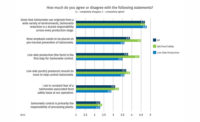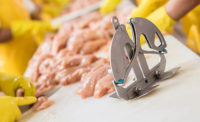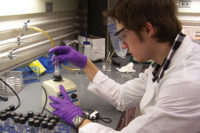Embracing a multi-hurdle approach for food safety in poultry
Implementing multiple steps from farm to plant maximizes risk reduction for Salmonella in poultry products.

Foodborne pathogens continue to pose a significant threat to American consumers. The Center for Disease Control and Prevention (CDC) estimates Salmonella bacteria alone cause about 1.35 million infections, 26,500 hospitalizations, and 420 deaths in the U.S. every year.1
The U.S. Department of Agriculture (USDA) Food Safety and Inspection Service (FSIS) announced in the fall of 2021 a new initiative aimed at reducing Salmonella illnesses linked to poultry production and processing. As stated by USDA Deputy Undersecretary Sandra Eskin, “Reducing Salmonella infections attributable to poultry is one of the department’s top priorities.”
FSIS is initiating several key activities to gather the data and information necessary to support future action and move closer to the national targets of reducing Salmonella illnesses by 25%.
The USDA FSIS is seeking stakeholder feedback on specific Salmonella controls and measurement strategies, including pilot projects in poultry processing plants, with a key component being to encourage preharvest controls to reduce Salmonella coming into the processing plant.2
Salmonella reduction preharvest 360o holistic approach
With the renewed focus on preharvest interventions to reduce Salmonella, many interventions warrant a closer look and deeper evaluation. This is where poultry producers and live operations managers play a crucial role. One way to describe effective preharvest Salmonella controls is to take a “360 degree approach.” These are the five key components:
- Vaccines can be used to build Salmonella immunity and offer protection throughout the life cycle, including the progeny.
- Intestinal integrity programs should be used to support bird immunity and reduce opportunities for Salmonella to colonize.
- Nutritional and functional feed supplements help mitigate Salmonella colonization while improving bird performance.
- Integrated Pest Management programs reduce external Salmonella vectors through the use of insecticides and rodenticides.
- Farm and poultry house best management practices reduce Salmonella proliferation through effective management of water, bedding material, biosecurity, and cleaning practices.

A shared responsibility to reduce Salmonella in poultry production
Reducing the risk of Salmonella in poultry products is an enormous responsibility that can’t be placed on the plant alone, as pathogen reduction is most successful when multiple steps are implemented along the entire continuum from farm to plant. Improved technologies in Salmonella quantification and detection preharvest have made measuring the impact of preharvest interventions more possible than ever before. New pathogen quantification lab methods have now made it more practical to begin bio-mapping earlier in the process, beginning when birds enter the plant and continuing all the way to final product.
By reducing Salmonella infections in live-bird operations, poultry producers can decrease the likelihood that Salmonella will be a plant problem, thus making plant interventions more effective.
Poultry companies need and should expect support from vendor partners to help develop new processes, technologies, and ideas to address pathogen concerns. Vendors of preharvest food safety technologies can offer services such as serotype lab analysis to verify vaccine effectiveness, field evaluations to understand the impacts of feed additives, and vector analysis to measure the effectiveness of insecticide rotations on reducing farm pests.
1cdc.gov/salmonella/ [Internet]. Washington: Centers for Disease Control and Prevention; 2022 [cited 2022 May 16]. Available from https://www.cdc.gov/salmonella/.
2 USDA launches new effort to reduce salmonella illnesses linked to poultry [Internet]. United States Department of Agriculture; 2021 [cited 2021Nov6]. Available from: https://www.usda.gov/media/press-releases/2021/10/19/usda-launches-new-effort-reduce-salmonella-illnesses-linked-poultry
Looking for a reprint of this article?
From high-res PDFs to custom plaques, order your copy today!








